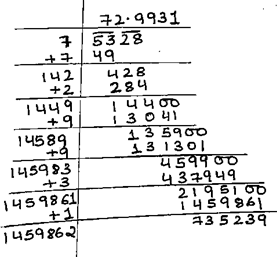Find the square roots of the following numbers to the fourth decimal place by the division method. Then write the approximate value of each square root up to the third, second and first decimal places.
5328
Square root of 5328 = 72.9931
Third decimal place = 72.993
Second decimal place = 72.99
One decimal place = 73.0(round figure of 72.9)

Step 1: Place a bar over every pair of digits starting from the one’s digit ![]()
Step 2: Find the largest number whose square is ≤ the number under the extreme left bar (72 <53< 82). Take this number as the divisor and the quotient with number under extreme left bar as the dividend. Divide and get the remainder.(4 in this case)
Step 3. Bring down the number under the next bar(i.e.,28 in this case)to the right of the remainder. So the new dividend is 428.
Step 4. Double the divisor and place this digit at ten’s place of new divisor (7+7 in this case)
Step 5. Guess the largest possible digit to fill the unit’s digit of new divisor which also become the new digit in the quotient, such that new divisor is multiplied to the new quotient the product is ≤ the dividend.
In this case 142 × 2 = 284. Get the remainder.
Step 6. Bring down the number under the next bar(i.e.,00 in this case) to the right of the remainder. So the new dividend is 14400. Put a decimal in quotient.
Step 7. Double the divisor and place this digit at ten’s place of new divisor (142+2 in this case).
Step 8. Guess the largest possible digit to fill the unit’s digit of new divisor which also become the new digit in the quotient, such that new divisor is multiplied to the new quotient the product is ≤ the dividend.
In this case 1449 × 9 = 13041. Get the remainder.
Step 9. Bring down the number under the next bar(i.e.,00 in this case) to the right of the remainder. So, new dividend is 135900
Step 10. Double the divisor and place this digit at ten’s place of new divisor (1449+9 in this case)
Step 11. Guess the largest possible digit to fill the unit’s digit of new divisor which also become the new digit in the quotient, such that new divisor is multiplied to the new quotient the product is ≤ the dividend.
In this case 14589 × 9 = 131301. Get the remainder.
Step 12. Bring down the number under the next bar(i.e.,00 in this case) to the right of the remainder. So the new dividend is 459900
Step 13. Double the divisor and place this digit at ten’s place of new divisor (14589+9 in this case).
Step 14. Guess the largest possible digit to fill the unit’s digit of new divisor which also become the new digit in the quotient, such that new divisor is multiplied to the new quotient the product is ≤ the dividend.
In this case 145983 × 3 = 439749. Get the remainder.
Step 15. Bring down the number under the next bar (i.e.,00 in this case) to the right of the remainder. So the new dividend is 2195100
Step 16. Double the divisor and place this digit at ten’s place of new divisor (145983+3 in this case).
Step 17. Guess the largest possible digit to fill the unit’s digit of new divisor which also become the new digit in the quotient, such that new divisor is multiplied to the new quotient the product is ≤ the dividend.
In this case 1459861 × 1 = 1459861. Get the remainder.
Step 18. The remainder is 735239, since, we were required to calculate the square root till 4th decimal place.
∴ ![]() = 72.9931
= 72.9931